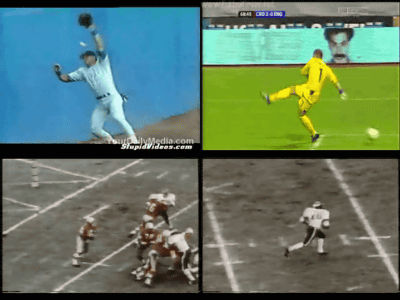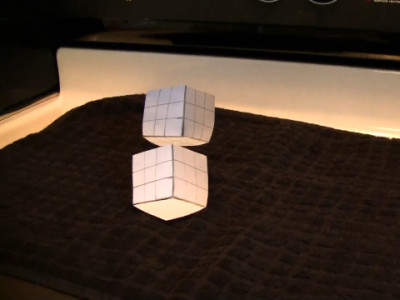Why does football's no-rotation kick or free kick take such an orbit?

David BeckhamYaRoberto Carlos"Freeing a track of a ball" Free kick is a phenomenon in which a force (lift) perpendicular to a uniform flow acts on a rotating ball placed in a uniform flow "Magnus effect"Says Ed Fontes, who works at COMSOL in physics simulation software development. And this Magnus effect and the official ball of the World Cup 2014 Brazil GamesBrazuca(Brazquea), using the numerical fluid dynamics (CFD) analysis results are also released.
The Magnus Effect and the World Cup ™ Match Ball | COMSOL Blog
http://www.comsol.com/blogs/magnus-effect-world-cup-match-ball/
The official ball "Brazooka" used in the Brazil World Cup of 2014 is a ball produced by Adidas, not a hexagonal and pentagonal panel stuck together like a regular soccer ball, but 6 It is made by pasting polyurethane panels.

ByGabriel Cabral
Fontes is a person who dreams of becoming a football player at a young age but was interested in car aerodynamics in the 1980s and eventually became an engineer of COMSOL. Such Fontes summarizes the influence of the aerodynamics he has learned and the rotation of the ball on the orbit of the ball.
◆ Ball and rotation
The rotation of the ball stabilizes the surrounding flow, and as a result it has the effect of stabilizing the ball's orbit.
In the case where the rotation of the ball is small or it is flying without rotation, when a solid is moved in the fluid, it is a row of vortexes which can be alternated behind itKarman vortex"Occurs behind the ball.
Karman vortex is made on the right side of the white circle at the left end.

The Karman vortex behind the ball not only produces drag but also moves the ball in an unexpected direction like an unpredictable trajectory when kicking a beach ball or a knuckle ball thrown by a baseball pitcher. Actually when a soccer player kicks a non-rotating ball, the ball's orbit becomes a so-called "blur ball" which the person himself who kicked the ball does not know.
Keisuke Honda Brake Sphere FK AMAZING !!! Keisuke Honda Freekick (Watch in HQ) - YouTube
The semi-chaotic ball trajectory of a non-rotating ball partiallyCFD moduleIt is possible to explain by using simulation.
The following figure simulates the Karman vortex that can be made behind a ball rotating counterclockwise on the equator at the same speed as the speed of the ball (that is, a relatively loosely rotating ball) with the CFD module.

From the top, it is like this that the Karman vortex occurs behind the ball, and the ball can be bent in an unpredictable direction by this whirlpool.

◆ Rotation and Magnus effect
As the rotation speed of the ball increases to some extent, the effect of the Karman vortex on the back of the ball decreases and it becomes completely balanced with the ball's traveling direction. So it seems very easy to predict the trajectory of a ball that makes a rotation over a certain speed.
The rotation speed of the ball and the air current repel each other, and the speed of the ball and the atmospheric pressure are also greatly related to the orbit of the ball. And especially when the speed of the ball drops and the rotation speed of the ball becomes relatively fast, the Magnus effect pulling the ball in the lateral direction strongly works, and the ball trajectory turns greatly.
This is a simulation image when the ball is seen from the traveling direction side. If only this is the case, I can only understand that the air current (yellow green vertical line) is greatly disturbed ... ...

When viewed from directly above, the Magnus effect works perpendicularly to the ball traveling direction, and if the ball is rotating clockwise it is turning counterclockwise 90 degrees to the right as heading in the ball's traveling direction Then you can see that force is applied to the left at 90 degrees.

You can understand what kind of trajectory the ball playing a strong rotation and Magnus effect will take by watching the following movie.
David Beckham's free kick against Greece - YouTube
◆ Ball design and turbulence
Consideration about the ball trajectory and the rotation of the ball is somewhat useful, but when simulating the trajectory of the soccer ball, "how the ball is structured" and "turbulence that can be behind the ball" It is an important factor.
Normal,Laminar flowMade up ofBoundary layerThen, the Separation Point where the air current leaves from the ball becomes as shown below, a large turbulence (drag) is created behind the ball, the speed of the ball will fall at a stretch.

Conversely,Turbulent flow, The Separation Point where the airflow leaves the ball is behind the case of laminar flow and the turbulence generated behind the ball becomes smaller, making it easier to maintain speed.

And the faster the speed of the ball the airflow around the ball changes from laminar to turbulent, and conversely if the velocity of the ball falls the airflow around the ball becomes laminar from turbulent flow.
However, it is the official ball of the World Cup 2010 South Africa GamesJabraniSince its release, research on ball design and ball trajectory has become more intense. Because unlike a soccer ball made up of 32 conventional black-painted pentagonal panels and 20 white-painted hexagonal panels, the Jabrani is made by pasting 8 special-shaped panels together It was because it was a finished ball.

The black part in the figure above is a seam between the panel and the panel, but this seam is fewer than the soccer balls so far. As a result, it will have a different drag coefficient, that is to say aerodynamic characteristics, than the previous balls, and the Jabrani will draw a completely different trajectory from the other balls. Specifically speaking about its characteristics, there was a growth in long kicks and middle shoots than usual, and the change in the ball also increased.
Brazza, the official ball of the 2014 tournament, is made up of a smaller number of panels than the Jabulani, but the length of the seams is about the same length as the traditional 32 panel balls. So, as you can see from the figure below, the drag coefficient of Brazooka (red) shows a value similar to that of a conventional ball (blue), and it draws a completely different trajectory from the Jabulani (green) I understand that it is deaf.

When the ball is kicked out on the outside (outside) of the spike, the ball will accelerate immediately to top speed, turbulence will occur around the ball and the ball will fly at high speed. And as the speed of the ball drops, the ball's speed of rotation will be relatively high, so Magnus effect will be more effective. In other words, the ball that kicked out comes straight at first at the beginning, but it suddenly bends quickly at the point where the speed fell.
This exquisite combination of turbulence and Magnus effect is a free kick that Roberto Carlos showed in Brazil against France held in 1997.
Roberto Carlos Best Goal - Free Kick Goal vs France (Tournoi de France 1997) - YouTube
If you look at the soccer match by putting these elements in the corner of the head, you can also pass through, saying, "The current free kick was Magnus effect was amazing ~".
Related Posts:







